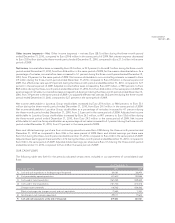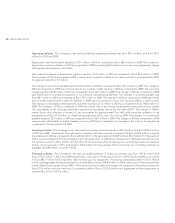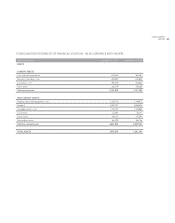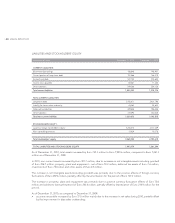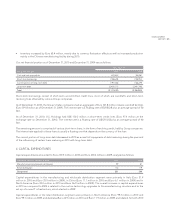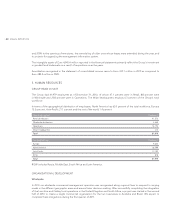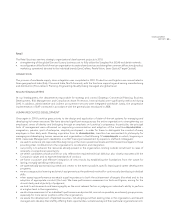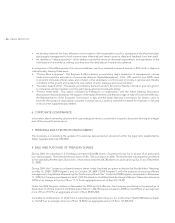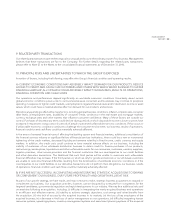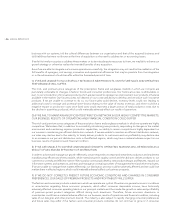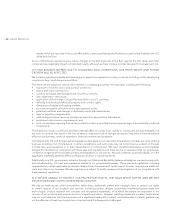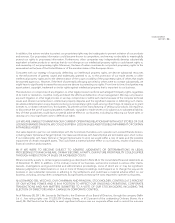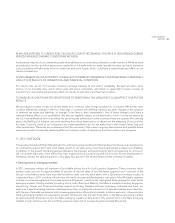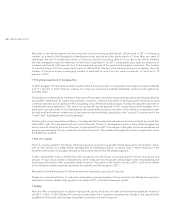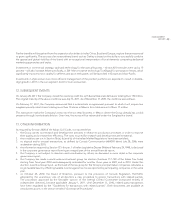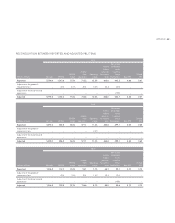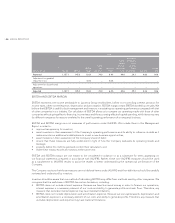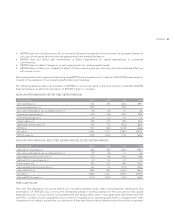LensCrafters 2010 Annual Report Download - page 59
Download and view the complete annual report
Please find page 59 of the 2010 LensCrafters annual report below. You can navigate through the pages in the report by either clicking on the pages listed below, or by using the keyword search tool below to find specific information within the annual report.|57 >
MANAGEMENT
REPORT
preferences shift away from our products. Changes in fashion could also affect the popularity and, therefore, the value of
the fashion licenses granted to us by designers. Any event or circumstance resulting in reduced market acceptance of one
or more of these designers could reduce our sales and the value of our models from that designer. Unanticipated shifts
in consumer preferences may also result in excess inventory and underutilized manufacturing capacity. In addition, our
success depends, in large part, on our ability to anticipate and react to changing fashion trends in a timely manner. Any
sustained failure to identify and respond to such trends could materially adversely affect our business, results of operations
and financial condition and may result in the write–down of excess inventory and idle manufacturing facilities.
G) IF WE DO NOT CONTINUE TO NEGOTIATE AND MAINTAIN FAVORABLE LICENSE ARRANGEMENTS, OUR
SALES OR COST OF SALES WILL SUFFER
We have entered into license agreements that enable us to manufacture and distribute prescription frames and sunglasses
under certain designer names, including Chanel, Prada, Miu Miu, Dolce & Gabbana, D&G, Bvlgari, Tiffany & Co., Versace,
Salvatore Ferragamo, Burberry, Polo Ralph Lauren, Donna Karan, DKNY, Paul Smith Spectacles, Brooks Brothers, Anne
Klein, Stella McCartney, Tory Burch and Coach. These license agreements typically have terms of between three and ten
years and may contain options for renewal for additional periods and require us to make guaranteed and contingent royalty
payments to the licensor. We believe that our ability to maintain and negotiate favorable license agreements with leading
designers in the fashion and luxury goods industries is essential to the branding of our products and, therefore, material
to the success of our business. For the years ended December 31, 2010 and 2009, the sales realized through the Prada and
Miu Miu brand names together represented approximately 4.2 percent and 4.7 percent of total sales, respectively. For
the years ended December 31, 2010 and 2009, the sales realized through the Dolce & Gabbana and D&G brand names
together represented approximately 3.5 percent and 4.0 percent of total sales, respectively. Accordingly, if we are unable to
negotiate and maintain satisfactory license arrangements with leading designers, our growth prospects and financial results
could materially suffer from a reduction in sales or an increase in advertising costs and royalty payments to designers.
H) IF VISION CORRECTION ALTERNATIVES TO PRESCRIPTION EYEGLASSES BECOME MORE WIDELY AVAILABLE,
OR CONSUMER PREFERENCES FOR SUCH ALTERNATIVES INCREASE, OUR PROFITABILITY COULD SUFFER
THROUGH A REDUCTION OF SALES OF OUR PRESCRIPTION EYEWEAR PRODUCTS, INCLUDING LENSES AND
ACCESSORIES
Our business could be negatively impacted by the availability and acceptance of vision correction alternatives to
prescription eyeglasses, such as contact lenses and refractive optical surgery. According to industry estimates, over 39
million people wear contact lenses in the United States, and the disposable contact lens market is the fastest growing
segment of the lens subsector. In addition, the use of refractive optical surgery has grown substantially in the United States
since it was approved by the U.S. Food and Drug Administration in 1995.
Increased use of vision correction alternatives could result in decreased use of our prescription eyewear products, including
a reduction of sales of lenses and accessories sold in our retail outlets, which could have a material adverse impact on our
business, results of operations, financial condition and prospects.
I) IF THE EURO OR THE CHINESE YUAN STRENGTHENS RELATIVE TO CERTAIN OTHER CURRENCIES OR IF THE U.S.
DOLLAR WEAKENS RELATIVE TO THE EURO, OUR PROFITABILITY AS A CONSOLIDATED GROUP WILL SUFFER
Our principal manufacturing facilities are located in Italy. We also maintain manufacturing facilities in China, India and the
United States as well as sales and distribution facilities throughout the world. As a result, our results of operations could
be materially adversely affected by foreign exchange rate fluctuations in two principal areas:
we incur most of our manufacturing costs in Euro and in Chinese Yuan, and receive a significant part of our revenues in •
other currencies such as the U.S. dollar and the Australian dollar. Therefore, a strengthening of the Euro or the Chinese
Yuan relative to other currencies in which we receive revenues could negatively impact the demand for our products
or decrease our profitability in consolidation, adversely affecting our business and results of operations; and
a substantial portion of our assets, liabilities, revenues and costs are denominated in various currencies other than •
Euro, with most of our revenues and operating expenses being denominated in U.S. dollars. As a result, our operating


